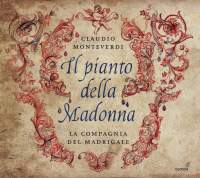Texte paru dans: / Appeared in: |
|
|
Outil de traduction ~ (Très approximatif) |
|
|
Reviewer: J.
F. Weber This is the fourth issue of music of this period by a group made up of singers who had already recorded a great deal of similar music with two other vocal ensembles. Their Gesualdo madrigals (Fanfare 36:6), Marenzio madrigals (37:4, but the first to be recorded), and Gesualdo responsories (37:6) all received the highest praise for performance, though the last lost ground only for its presentation with inappropriate additions. Most of the music of Monteverdi recorded here consists of contrafacta on the composer’s madrigals arranged by two men: the Benedictine monk Angelo Grillo, writing as Livio Celiano, and a professor of rhetoric at Pavia, Aquilino Coppini. Also included are spiritual works that were published in two books in 1620 by a cornett player and pupil of Monteverdi at the court of Mantua, Giulio Cesare Bianchi. The opening piece on the program is as familiar as its original, the Lamento d’Arianna. It is also the longest piece heard here, and it gives the disc its title. The concluding Litany for six voices, nearly as long, is found in the second 1620 collection. Jeffrey Skidmore once recorded a whole disc of Coppini’s contrafacta from Books 4 and 5 (21:3), although he reversed the titles, identifying the group from Book 5 as Book 4 and vice versa. Five selections from Book 5 are included here. All five of Bianchi’s motets heard here were included in Roberto Gini’s two-disc collection of Monteverdi’s sacred music (29:5), but they have been recorded elsewhere as well. Since two of Gini’s motets and all of Skidmore’s program were sung by large choirs, the present vocal ensemble is preferable for historically informed performance, vocal tone and precision, and interpretive insight. I’m not sure what the two brief organ toccatas add to the program, but the period organ sounds good. Despite the timing of the four reviews, the group is actually keeping a schedule of an annual recording, so we can expect another fine issue soon. Very fine on all counts. | |
|
|
|
|
Cliquez l'un ou l'autre
bouton pour découvrir bien d'autres critiques de CD |
|




